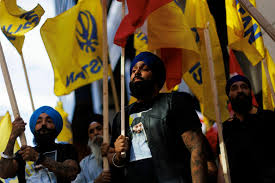Written by: Ahmad Ali
In India, Hindutva-dominated politicians from the Hindi heartland have used brutal force against any attempt to free Assam, Kashmir, Khalistan, Mizoram, Nagaland, Tamil Nadu, Tripura, Arunachal Pradesh, Meghalaya, and Manipur, where liberation efforts are still ongoing in some form. Many armed and brutal rebellions rock these states, some seeking independent states, others battling for autonomy.
Since becoming Prime Minister of India, Narendra Modi, the head of the ruling BJP, has begun to enforce Hindutva doctrine. Under his administration, hardline Hindus have expanded persecution of religious minorities, including Christians, Muslims, and Sikhs, as well as lower-caste Hindus such as Dalits. Meanwhile, India’s counterterrorism policy to crush separatist movements has failed miserably.
According to Human Rights Watch’s 2017 annual report, authorities continue to employ sedition and criminal defamation legislation to pursue civilians who criticize government policy. On a few occasions in 2016, police were held liable for violations. In April 2021, 47 police officers were convicted to life in jail for their roles in the 1991 massacre of 11 Sikhs in Uttar Pradesh’s Pilibhit region. Despite efforts to remove the Armed Forces Special Powers Act, soldiers remain immune from punishment when deployed in areas of domestic turmoil.”
The US Commission on International Religious Freedom reported a decline in religious tolerance and an increase in religious freedom violations in India. Minority communities like Sikhs faced several episodes of intimidation, harassment, and violence, primarily from Hindu nationalist parties. Sikhs have been fighting for a separate homeland since 1947. Still, the movement was fueled by the efforts of SantJarnail Singh Bhindranwale, which in June 1984 resulted in the most brutal operation against a highly sacred Sikh religious site, the Golden Temple complex (Harmandir Sahib) in Amritsar, Punjab, killing thousands of Sikhs. The Indian Army, led by Maj Gen Kuldip Singh Brar, smashed all records of state terrorism and extrajudicial killings during brutal Operation Blue Star, which then-Prime Minister Indira Gandhi ordered to seize control of the Harmandir Sahib complex.
In this context, Ramnarain Kumar and George Sieberer wrote in their book, The Sikh Struggle, that “the army killed every Sikh who could be found inside the temple complex.” They were dragged from their quarters and led to passageways around the temple, where they were shot in cold blood with their wrists tied behind their back. Victims included elderly men, women, and children. However, all guests were imprisoned in rooms for two days without food, drink, or electricity and starved to death. Furthermore, the Harmandir Sahib remained under army control for months.”
In November of the same year, two committed Sikh police officers named Beant Singh and Satwant Singh killed Prime Minister Indira Gandhi at her New Delhi house. Then, Hindu riots erupted in the capital and other places, and more than 15,000 Sikhs were slaughtered in cold blood by Indira Gandhi’s followers. At the same time, the police stood by silently, allowing Hindus to kill Sikhs. Nonetheless, the attack on the Harmandir Sahib and the massacre of Sikhs propelled Khalistan’s liberation cause, with Bhindranwale becoming a folk hero.
In 1987, another attack on the Temple was launched under the codename ‘Operation Black Thunder’. At the time, the primary goal was Sikh opposition, which was a logical result of the tragedy. Following that, ‘Operation Woodrose’ and ‘Operation Black Thunder-II’ were launched against the Sikh community, resulting in their extrajudicial assassination. Following these barbarous activities, Sikhs formed an armed force to combat Indian governmental terrorism. Many Sikhs left India to avoid religious persecution. Sikhs have migrated throughout the world to keep the Khalistan movement alive.
Now, New Delhi and the Indian intelligence agency RAW are attempting to divide the Sikh community across platforms in the United States, United Kingdom, Canada, Australia, and Pakistan. Notably, the Khalistan movement, which has increased among Indian Sikh youth, has been internationalized. In this regard, thousands of Sikhs assembled at Trafalgar Square, London, on August 12, 2018. The Sikh community rejected Article 25(b)(2) of the Indian Constitution, which deems Sikhism a branch of Hinduism. Earlier, Gopal Singh Chawla, the leader of the Khalistan independence movement, said that “Peace for Sikhs” has expedited the registration process for the 2020 Khalistan referendum. He has asked the other Sikh leaders to resign and join the campaign. He has stated that 11000 to 13000 Sikh leaders have already quit the Indian Army without rewards to join the Khalistan movement—from now on, Sikhs will only fight for Khalistan.
In recent years, the Indian government’s escalating campaign against the Khalistan movement has taken a dangerous turn, marked by targeted assassinations of Sikh leaders in countries such as Canada, the USA, Pakistan, and Australia. This aggressive stance culminated in Canada expelling the Indian ambassador, a significant diplomatic setback that left India both embarrassed and exposed on the international stage. These actions represent a blatant violation of other nations’ sovereignty and a disregard for international law and established diplomatic norms. Nonetheless, Modi’s extreme tactics against Sikhs have ignited the Khalistan independence movement.
The implications of this crisis extend far beyond immediate political repercussions; they signal the alarming influence of extremist Hindutva ideology on India’s foreign policy. The Modi administration’s desperation to crush dissent reflects a broader trend where the rights and voices of minority communities are systematically suppressed, both domestically and abroad. This troubling shift poses serious questions about the values that underpin a nation of 1.2 billion people as the state increasingly resorts to intimidation and violence to silence calls for self-determination.
Ahmad Ali is a research fellow at Epis Think Tank Germany and an intern at the Kashmir Institute of International Relations. His fields of study include foreign policy and Conflict Resolution. He can be reached at Ali7664556@gmail.com.










